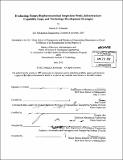| dc.contributor.advisor | Roy Welsch and Douglas Hart. | en_US |
| dc.contributor.author | Hollander, Marnix E. (Marnix English) | en_US |
| dc.contributor.other | Leaders for Global Operations Program. | en_US |
| dc.date.accessioned | 2012-11-19T19:18:28Z | |
| dc.date.available | 2012-11-19T19:18:28Z | |
| dc.date.copyright | 2012 | en_US |
| dc.date.issued | 2012 | en_US |
| dc.identifier.uri | http://hdl.handle.net/1721.1/74919 | |
| dc.description | Thesis (S.M.)--Massachusetts Institute of Technology, Dept. of Mechanical Engineering; and, (M.B.A.)--Massachusetts Institute of Technology, Sloan School of Management; in conjunction with the Leaders for Global Operations Program at MIT, 2012. | en_US |
| dc.description | Cataloged from PDF version of thesis. Page 70 blank. | en_US |
| dc.description | Includes bibliographical references (p. 61-62). | en_US |
| dc.description.abstract | The biotechnology industry is undergoing a paradigm shift in the properties of the manufactured drug product. As therapeutic protein formulations change from agonist to antagonist methods of action, the concentration of proteins in each dose increased by orders of magnitude, and with it, the challenge of producing and inspecting the product. Current inspection technologies meet the requirements to properly inspect the existing drug product portfolio, but as new pipeline drugs enter commercial manufacturing, inspection will become a pressing issue from operational efficiency, compliance, and quality standpoints. It is known that the properties of some of these pipeline products render them "uninspectable" by currently installed Automatic Visual Inspection Machines (AVIMs) but the scale and scope of the challenge is not well defined currently. The process and approach outlined in this research focuses on distilling large datasets of future product forecasts together with product attributes and infrastructure capability to generate a quantitative understanding of the future challenge. Through this research, product attributes critical to inspection such as viscosity, presentation, and protein aggregation, are identified for each commercial and pipeline drug product. These attributes are paired with production forecasts to generate attribute focused inspection requirements through 2020, which are then mapped against current capabilities. Gaps identified between requirements and current infrastructure capabilities are determined and the scale quantified. These capability gaps are then segmented by potential solutions, complexity of solutions, and cost of inaction in order to give Amgen the best foresight into future decisions and investments. Based on the gaps identified and near term engineering challenges, several solutions are developed, proposed, and tested throughout the internship. These include the use of Surface Acoustic Waves (SAW) to agitate heavy particles into suspension through acoustic streaming, enhanced lighting and imaging techniques to better identify particles, and segmented machine vision algorithms. These approaches are part of a larger portfolio of technical solutions which must be developed to address future product attributes which render current inspection processes ineffective. | en_US |
| dc.description.statementofresponsibility | by Marnix E. Hollander. | en_US |
| dc.format.extent | 70 p. | en_US |
| dc.language.iso | eng | en_US |
| dc.publisher | Massachusetts Institute of Technology | en_US |
| dc.rights | M.I.T. theses are protected by
copyright. They may be viewed from this source for any purpose, but
reproduction or distribution in any format is prohibited without written
permission. See provided URL for inquiries about permission. | en_US |
| dc.rights.uri | http://dspace.mit.edu/handle/1721.1/7582 | en_US |
| dc.subject | Mechanical Engineering. | en_US |
| dc.subject | Sloan School of Management. | en_US |
| dc.subject | Leaders for Global Operations Program. | en_US |
| dc.title | Evaluating future biopharmaceutical inspection needs, infrastructure capability gaps, and technology development strategies | en_US |
| dc.title.alternative | Evaluating future biopharmaceutical product inspection needs, capability gaps, and technology investment strategies | en_US |
| dc.type | Thesis | en_US |
| dc.description.degree | M.B.A. | en_US |
| dc.description.degree | S.M. | en_US |
| dc.contributor.department | Leaders for Global Operations Program at MIT | en_US |
| dc.contributor.department | Massachusetts Institute of Technology. Department of Mechanical Engineering | |
| dc.contributor.department | Sloan School of Management | |
| dc.identifier.oclc | 815725165 | en_US |
